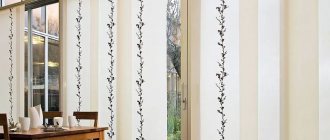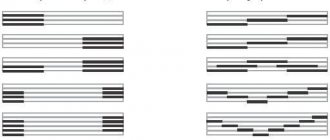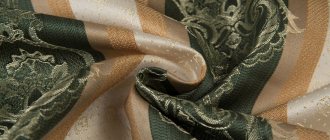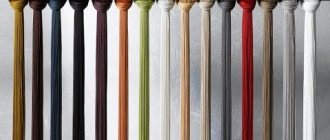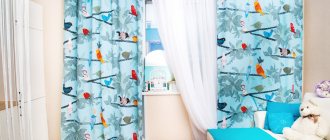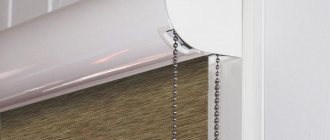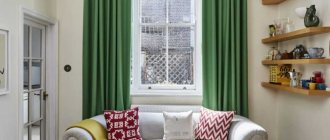Japanese curtains are an exotic decorative element that came to us from the Land of the Rising Sun.
It is increasingly used in interiors, bringing into them a piece of the mysterious East. Anyone who is a little familiar with the Japanese culture knows how simply and modestly their small homes are furnished. Built-in wardrobe, low bed or thick mat, small table for meals and tea ceremonies.
Perhaps the only decoration of such an interior are curtains. They are also called Japanese panels. And indeed it is.
Japanese curtains are strips of dense fabric, no more than 50-60 centimeters wide. They are attached to the ceiling rail and cover the entire window space from top to bottom.
The kit includes several panels; they can be of different colors and textures. This gives the interior an interesting touch.
Typically, such curtains cover the entire wall where the window is located. This visually expands the space of the room.
Advantages and disadvantages of Japanese curtains
In recent years, the popularity of Japanese-style curtains has been constantly increasing; they have a number of advantages:
- There is no need to limit your imagination in choosing the color and texture of the fabric.
- The products are easy to care for and cleaning will not take much time. Dirt practically does not cling to the panels.
- You don't need a professional to hang curtains. All work is considered simple; anyone can handle it.
- Japanese curtains consist of a small amount of materials. To create standard models, many times more fabric would be required, and the price of the finished product would be higher.
- The canvases are perfect for use in rooms where the bright sun often shines. The entire living space will be well protected from harsh and blinding rays. The lighting will still be natural, but more diffused and softer.
In order to hang the panels, you do not need to call a specialist.
The only significant drawback of curtains against the background of their advantages is the small choice in terms of shapes. Often you have to consider two options: square and rectangular.
The shape of curtains can be square or rectangular.
Materials for Japanese curtains in the interior
In order to make panels for windows, almost any fabric is suitable, but silk, cotton or linen are most often used.
Sometimes curtains can be made from polyester or acrylic, as well as materials containing natural and artificial fibers.
Depending on what function the curtains should serve, lighter or heavier fabrics are selected. If the windows are not on the sunny side, the curtains can be translucent, and for partitions separating zones, thick and dark curtains are usually chosen.
Despite the huge selection on the market, designers continue to experiment with combinations of colors and textures.
Windows are now decorated not only with panels made of fabric, but also with curtains made of bamboo sticks or curtains made of rice paper.
This makes it possible to experiment with Japanese curtains in the interior and create a unique design for any room.
Selecting fabric type and color
To create classic curtains in the Japanese style, natural materials are used, and they are not necessarily fabric. The following materials are used in production: thick rice paper, jute, straw or bamboo plates. At first, curtains were produced in one tone, and did not play the role of decoration, only functionality was important.
In the modern world there are no restrictions in the choice of materials; everyone can find an option that will suit their unique home interior.
For those who strive for eclecticism, it is better to pay attention to fabrics with different textures and shades. Carefully ensure that the canvases fit well together.
You can combine fabrics of different textures and colors.
To ensure that the shape of the product is not lost over time, choose fabrics made from linen, silk, satin, cotton; these materials are dense and do not stretch. They can be interestingly combined with translucent moire or chiffon panels.
Curtains made of thick materials are more durable.
If the interior is made in a minimalist style, then it is better to choose a single-color canvas with a small pattern. Curtains with plant motifs are widely popular.
The plant motif is in wide demand.
Advice. In all other cases, the use of bright colors and catchy prints is allowed.
Japanese curtains in the interior of different apartments and rooms
The best room to hang Japanese curtains is a large room with windows along the entire length of the walls. Therefore, panels are often used in interior design in shops, offices or private homes.
But this does not mean that such products cannot be used in a small apartment; on the contrary, the absence of unnecessary details and multi-layer drapery will only be beneficial. Light panels create a feeling of spaciousness and also visually lengthen the windows.
Japanese curtains can be hung in any room, but for each room you need to choose different models.
So, in the bedroom it is better not to use curtains of bright colors, otherwise you will not be able to relax and sleep well at night.
If you like to wake up with the first rays of the sun, then you can choose products made from translucent fabrics. And curtains made of thick material in calm colors will help you hide from prying eyes.
In the living room, first of all, you should focus on the concept and color scheme. If curtains are chosen not only for windows, but also to enclose the dining area, they should be combined with each other.
For the kitchen, it is better to choose panels made from lightweight materials, because this room requires an abundance of light. Translucent printed curtains are the ideal solution.
The brightest window curtains are best hung in the nursery. You can choose models with geometric patterns and images of cartoon characters.
If you want to hang curtains in the work area, then it is better to choose plain dark models, for example, gray or brown, so that they do not distract. But in this case you need to take care of good lighting.
Japanese panels
The appearance and other characteristics of Japanese curtains are very different from the usual type of window decor. The screen panels have a special design: there is a holding element in the upper part, there is also a base and a weighting agent. There should be no difficulties in using the products. All components are wear-resistant and functional.
Japanese curtains are functional and easy to use.
Japanese panels have interesting features:
- the operating system is associated with blinds, the products may have sections, their number is related to the size of the window frame;
- the width of one sectional canvas can be more than 100 centimeters;
- curtains must be controlled using a special chain, cord or remote control;
- the panels move like a screen; this principle is considered modern and convenient.
The design of Japanese curtains has its own characteristics.
Each piece of Japanese paintings is a unique product that combines beautiful colors and new technologies.
Japanese drawing
The images on Japanese curtains can be varied, most often the designs reflect the motives of the native state. At the market you can find products with cherry blossoms, hieroglyphs, dragons or Mount Fuji.
Several ornaments look great on the panels. The most discreet option would be curtains made in natural colors with geometric patterns. If the interior needs an expressive spot, choose curtains with bright and large patterns.
For a restrained interior, you can use geometric patterns.
Panel space is a canvas open to extraordinary ideas, but it is advisable not to use popular photo printing on fabric. The image should look natural, as if the work was done by hand. Traditional landscapes applied to canvas using ink or paint will look most appropriate on curtains.
Interior Japanese curtains
Doors are an integral part of many rooms. Japanese curtains can be used as interior partitions. The design according to the description will be almost the same as for window decoration: panels and cornices. The key difference is that the doors will be made of denser and harder material: cotton, bamboo, reed.
Japanese panels are often used as interior partitions.
The main advantage of such products is that such panels open conveniently, hiding behind each other, they do not take up much space. Japanese curtains will add lightness and transparency to the interior, replacing traditional interior models well.
Sliding panels add lightness to the room.
Doors usually use several panels; the height of the product can be from floor to ceiling. Cornices can be mounted at any level, it all depends on the preferences of the homeowner.
Japanese curtains in the interior - designer tips
Curtains look different in different lighting. Therefore, it is necessary to check how the panels look not only in daylight, but also in the evening. You may need to try a few different bulbs to complement the curtain design without ruining the harmony.
If you need to create the effect of a real wall, then you need to choose curtains only from dense materials.
Do not use Japanese curtains when creating classic interiors and do not combine them with vintage and retro style details.
If you want to use some image to decorate curtains, it is better not to “stretch” the image into several panels.
Select a small image and multiply it or print several different details in the same style. In addition, you can experiment and alternate plain curtains with printed panels.
Friends, subscribe to our Instagram @dekodiz.ru, there you will find inspiration and a sea of ideas for interior design!
Japanese style curtains
Japanese curtains are considered more convenient to use than standard textile counterparts. The canvas is tightly stretched over the cornice, there are no folds, so the curtains get dirty less often and less often. Some materials can be washed, and the design is formed in such a way that the fabric can be easily removed from the window and then hung in its place.
Japanese curtains do not form wrinkles and are less likely to get dirty.
For your information! Japanese-style curtains will last a long time and do not require much maintenance. Sun rays are not dangerous for products.
Japanese curtains in the interior and their advantages
“Panel” curtains are more convenient to use than regular ones. Due to the fact that the fabric on the curtain rod is tightly stretched and does not have folds, less dirt and dust settles on it.
Also, thanks to Velcro, the curtains can be easily removed to wash them. The absence of hooks also allows any housewife to easily and quickly hang the fabric back.
Such curtains will last a very long time, because they are almost always made from natural fabrics of good quality. The products will not fade in the sun and will not lose their appearance when washed.
Photo of interior design ideas
If the interior is decorated in a minimalist style, then the ideal option for additional discreet decoration would be Japanese curtains; photos of numerous examples can be found on the Internet. It is better not to use curtains in a room with pompous decor, where there are a lot of bright elements.
When creating an interior in accordance with the traditions of Japan, follow a simple rule: everything unnecessary is a disgrace. The main highlight of the design is the presence of a large empty space; a minimal amount of furniture is allowed. In the rooms it is appropriate to use large elements in the form of images, paintings and mosaics.
The Japanese-style interior is distinguished by its laconicism and the absence of unnecessary elements.
Kitchen
When adding Japanese motifs to the kitchen, turn to Eastern traditions. In the room where food is prepared and eaten, a harmonious and concentrated atmosphere should reign, otherwise the food will not be beneficial. To decorate your kitchen space, it is better to choose curtains with delicate and unobtrusive patterns.
For the kitchen it is better to choose a neutral and unobtrusive pattern.
If the overall interior style does not contradict the idea, complement the window panels with light, natural shades that will be associated with living nature: green, light brown.
For greater convenience, it is better to purchase a shortened version of curtains. These models are much easier to clean. In eco-style, the ideal option would be canvases made from special straw or decorative bamboo sticks.
Living room
Japanese curtains, as can be seen from many photos on the Internet, fit perfectly into the interior of the living room. Experts advise not to limit yourself to dark colors, but to try a small experiment by choosing a light and textured curtain to decorate the room.
In the living room you can use a light and light option.
Panels made of translucent veil will add romance to the room and give the design an elegant look. Don’t be afraid to use bright and rich colors, as well as unusual textures, in your living room. Flashy elements are not a sign of bad taste.
You can also use bright colors.
Bedroom
The bedroom is a place for relaxation, so to create a relaxed mood it is better to choose calm and pastel colors in the design. Curtains with floral or graphic patterns and natural light will add coziness to the room.
A floral pattern in soft pastel colors is suitable for the bedroom.
Do not overload the space with panels; it is enough to use two or three pieces in a sleeping room. It is advisable to choose a material of medium density, without a lot of ornamentation.
Japanese curtain design ideas
To make the room seem more comfortable, it is recommended to combine several curtains made of light and dense material. Experts advise you to immediately purchase a couple of ready-made interior decoration options so that you can quickly change them if desired.
Unusual decor is perfect for zoning large living rooms, lofts or small studio apartments.
Japanese curtains can be used to zone a studio.
When choosing the theme and color of the curtains, be sure to focus on the overall design of the home. Keep in mind that it is better not to mix Japanese style with other styles. It is well able to emphasize the ideas of brevity, the design will look quite original.
Japanese curtains in the interior - cleaning or washing?
Please note that not all Japanese curtains can be washed. For example, if they are made of bamboo, then the dust from them needs to be brushed off with a special brush or dry sponge.
If the curtains are made from natural fabrics, it is better to contact specialists and have the products dry cleaned.
It is better to wipe panels made of artificial fabrics with a damp sponge soaked in a solution with a suitable cleaning agent.
If they are heavily soiled or during general cleaning, the curtains can be washed by hand, unless, of course, this is indicated in the instructions.
How to attach Japanese curtains
Fabric panels can be attached to a standard or multi-row cornice. The structure is fixed either on the wall or on the ceiling. For zoning living space, it is recommended to use not only straight, but also curved cornices.
Standard material is aluminum or plastic. The panels are attached to the base using Velcro. This solution makes the curtains easy to use, easy to remove and hang.
Velcro is used to attach curtains.
Curtain rods with multiple tracks allow panels to be placed behind each other, which saves space. You can place several interior elements on one row without increasing the width of the structure.
Several tracks allow you to wind the panels behind each other.
Panel curtains can be either manually controlled or remotely controlled. The second option will require the installation of a quiet electric motor, which is software linked to the remote control.
How to combine Japanese curtains in the interior with different styles
“Clothing” for windows in the form of panels fits into many interiors, but designers mainly resort to the use of Japanese curtains, creating designs in the following styles:
East style
It was for this style that fabric panels were invented. When creating an interior like in the Land of the Rising Sun, you should give preference to plain curtains in bright colors. You can often also see curtains with painted hieroglyphs, the sun or sakura.
Eco style
To create an ecological style in any room, the use of natural materials is required, so windows covered with panels made of rough linen will look great. Curtains made from bamboo or rice paper will also look interesting.
Modern style
Japanese curtains in the interior look very modern, and if you hang the fabric correctly, you can create original asymmetrical pictures.
High tech
This style is characterized by rigor and elegance, so the panels also fit perfectly into such an interior.
In this case, it is better to purchase products made from unusual fabrics, for example, with a metallic sheen or translucent curtains that look like frosted glass or plastic.
Minimalism style
The simple design and laconic rectangular shape of the curtains fit perfectly into this style. You can choose plain panels and combine several colors to create accents.
DIY cornice for Japanese curtains
Japanese curtains are a practical and elegant decor, the basis of which is represented by a cornice. The structure can be mounted above any part of the room; the location does not play a big role.
To create a cornice with your own hands, you will need tools and high-quality materials. Be sure to pay attention to the weight of the finished product. Plastic is considered fragile and will not cope with large loads; for a large number of panels, steel will be required.
For a high-quality cornice, it is better to choose steel rather than plastic.
To secure the cornice in the chosen location, use a drill and screwdriver. Do not place curtains close to heating elements or window sills. Curtains should flow freely.
Place the cornice exactly on the intended area, mark the attachment points with a pencil. Then drill holes and secure the product tightly. After completing the work, you should check the reliability of the resulting structure.
Japanese-style curtains can be purchased at any boutique that specializes in home textiles. If you want to get something unique, order curtains from a workshop, or create them yourself.
DIY master class (step-by-step instructions)
Many home improvement and repair stores offer ready-made kits for hanging Japanese curtains. The panel curtains themselves can be sewn with your own hands, or you can order them from a curtain making studio. The latter option is more expensive and not as exciting as the first.
We offer you a small master class with step-by-step instructions on how to make Japanese curtains with your own hands.
You cannot make a cornice yourself. It is better to buy a ready-made kit in the store.
STEP 1 Install the cornice for Japanese panels in the desired location according to the instructions included with them. STEP 2 Calculate the amount of fabric needed for sewing. This will depend on the length of the panels, their width, combination and the width of the room itself. For example, the width of the room is 3.60 meters, the height is 3 meters. All panels must be end-to-end. We make 6 panels of 60 centimeters each. Add allowance for hemming the edges and shrinking the fabric. We get 6 cuts 305 by 65 centimeters. STEP 3 Cut them out of fabric. STEP 4 Iron the panels thoroughly. STEP 5 Hem the side edges with a hem stitch. STEP 6 We bend the bottom edge of the panels and hem them in the form of a drawstring. STEP 7 Fold the top edge to the width of the Velcro and stitch. You can also process the upper edge in the form of a drawstring to insert the straightener there. STEP 8 Sew curtain tape or Velcro onto the top edge of the wrong side of the panel. STEP 9 We insert a rectifier into the drawstring at the top of the panels, and a weighting agent at the bottom. STEP 10 Attach the panels to the cornice.
Japanese style curtains are ready.

